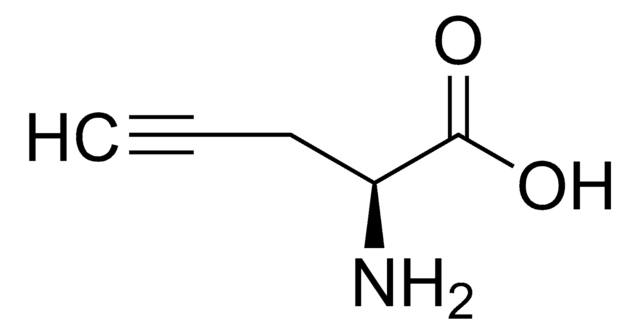Kluczowe dokumenty
P7888
DL-Propargylglycine
cystathionine γ-lyase inhibitor
Synonim(y):
2-Amino-4-pentynoic acid, PAG
Wybierz wielkość
421,00 zł
Wybierz wielkość
About This Item
421,00 zł
Polecane produkty
Poziom jakości
Próba
≥98% (TLC)
Formularz
powder
kolor
white
Zastosowanie
cell analysis
temp. przechowywania
−20°C
ciąg SMILES
NC(CC#C)C(O)=O
InChI
1S/C5H7NO2/c1-2-3-4(6)5(7)8/h1,4H,3,6H2,(H,7,8)
Klucz InChI
DGYHPLMPMRKMPD-UHFFFAOYSA-N
Powiązane kategorie
Zastosowanie
- Metabolic Labeling Strategy Boosted Antibacterial Efficiency for Photothermal and Photodynamic Synergistic Bacteria-Infected Wound Therapy.: This study demonstrates the enhanced antibacterial efficiency of a metabolic labeling strategy using ᴅʟ-Propargylglycine in photothermal and photodynamic therapy for treating bacteria-infected wounds (Li et al., 2022).
- Metabolic Labeling of Peptidoglycan with NIR-II Dye Enables In Vivo Imaging of Gut Microbiota.: This research utilizes ᴅʟ-Propargylglycine for metabolic labeling, allowing near-infrared II imaging of gut microbiota in vivo, providing new insights into microbiome studies (Wang et al., 2020).
- Hydrogen sulfide upregulated mRNA expressions of sodium bicarbonate cotransporter1, trefoil factor1 and trefoil factor2 in gastric mucosa in rats.: Investigates the role of ᴅʟ-Propargylglycine, in upregulating specific mRNA expressions in gastric mucosa, with implications for gastrointestinal research (Cheraghi et al., 2016).
Działania biochem./fizjol.
Hasło ostrzegawcze
Warning
Zwroty wskazujące rodzaj zagrożenia
Zwroty wskazujące środki ostrożności
Klasyfikacja zagrożeń
Eye Irrit. 2 - Skin Irrit. 2 - STOT SE 3
Organy docelowe
Respiratory system
Kod klasy składowania
11 - Combustible Solids
Klasa zagrożenia wodnego (WGK)
WGK 3
Temperatura zapłonu (°F)
Not applicable
Temperatura zapłonu (°C)
Not applicable
Środki ochrony indywidualnej
dust mask type N95 (US), Eyeshields, Gloves
Wybierz jedną z najnowszych wersji:
Masz już ten produkt?
Dokumenty związane z niedawno zakupionymi produktami zostały zamieszczone w Bibliotece dokumentów.
Klienci oglądali również te produkty
Active Filters
Nasz zespół naukowców ma doświadczenie we wszystkich obszarach badań, w tym w naukach przyrodniczych, materiałoznawstwie, syntezie chemicznej, chromatografii, analityce i wielu innych dziedzinach.
Skontaktuj się z zespołem ds. pomocy technicznej














